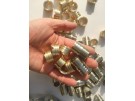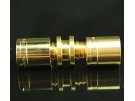Tech News
Machining difficult materials like Titanium and Stainless Steel is a scary business if you own a smaller CNC machine. Even doing aluminum versus plastics and woods can be daunting. Our article on machining aluminum for CNC Routers is one of the most popular we’ve ever done, for that reason. But here is the surprising thing:
Provided your machine will achieve the correct feeds and speeds, you can successfully machine most any material you want.
I don’t say that lightly, and I will hasten to add that it isn’t just about feeds and speeds and that getting to the correct feeds and speeds may not be enough. I should also add that successfully machining the material does not mean you’ll achieve the accuracy or surface finish of a high end Vertical Machining Center. But, you can machine the material and you can get surprisingly good results.
Why?
The answer is that despite the fact you have a small machine rather than a full VMC, you still get to use some of the same tooling as that VMC. You can pop a premium endmill into your machine and cut with it. That’s not the whole battle, but it is hugely helpful. The tool has the hard job–it’s stuck between your machine and that nasty tough material. But, with proper feeds and speeds, the tool is already feeling more up to the task. You’ve eliminated a big part of what’s different about your small machine and that VMC. Keep minimizing those differences from the cutter’s perspective, and you’ll be doing well in no time.
Here’s what you need to do to be successful machining tough materials:
Like I said above, you can use the same cutters (barring not using cutters that are too big and aggressive) in your small machine as one can use with a VMC. Buy a decent brand of carbide endmill. It doesn’t need the ultimate solid green unobtanium coating, but make it carbide for rigidity and toughness. A decent brand will have a little better geometry than a no-name. You don’t want discount no-name cutters trying to bite into your difficult material–they’re not up to the job.
Another thing, use cutters intended for light cuts. This is not so much an issue for endmills, but when looking at indexable tooling, you want the sharpest possible inserts. In all likelihood, you may not even want indexable tooling for mills, but it works fine on small lathes. On a light mill, forget a big (3″ is BIG for these machines) facemill with 6 inserts. Try a flycutter or a smaller facemill.
For roughing, instead of a fancy indexable endmill, try a corncob (serrated rougher). These work great on lighter machines if your machine will take one of a decent size.
One really nice feature of these cutters is the serrations result in smaller chips, which makes it easier to keep the chips clear (see below).
One of the reasons difficult materials are difficult is they have smaller feeds and speeds sweet spots. I have people ask all the time about listing more woods due to differences in wood hardnesses. The reality is that not even the cutter makers deal with those differences because carbide is so much tougher than any wood that the differences do not matter. You need a few categories to deal with other differences, but in general, Wood has a big sweet spot. Plastics have big sweet spots. Aluminum and Brass, easily machined metals, have big sweet spots. Titanium and Stainless, not so much.
You can only hit those smaller more difficult sweet spots by having good Feeds and Speeds. And here’s the thing–you are only going to get good feeds and speeds with a calculator. You can’t hear the right feeds and speeds–if you could, there’d be CD’s you can buy and Boeing would make all their machinists train their ears with those CD’s. You can hear when things are way wrong, but by then, that tough material has eaten the liver out of your tool. It’s done and ready to pack up.
Plus, the conditions you’ll need to deal with the tough material, particularly on small machines, mean you need to deal with all the subtle nuances of calculating feeds and speeds. For example, if you want to take lighter cuts, you had better account for chip thinning. If you’re on a light machine, your Feeds and Speeds had better account for the shape of the machine’s Spindle Power Curve, lest it pick a range where the spindle is struggling without enough power.












